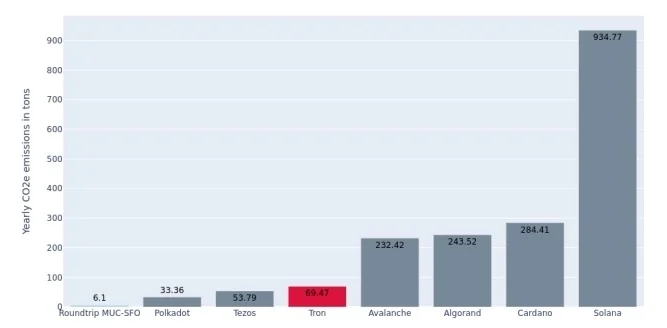The Tron network’s annual electricity consumption is equivalent to that of just 15 U.S. households, according to a report prepared by the Crypto Carbon Ratings Institute.
The commissioned report produced on behalf of the Tron network found that as of July 2022, Tron’s annual electricity consumption stands at 162,868 kWh.
Per the U.S. Energy Information Administration, the average annual electricity consumption of a U.S. household was 10,715 kWh in 2020, meaning that the Tron network uses just over 15 U.S. households’ worth of energy each year.
Bitcoin’s energy consumption currently stands at 94.47 TWh, per the most recent figures from the Cambridge Bitcoin Electricity Consumption Index—meaning that Tron uses less than 0.001% of the energy consumed by the proof-of-work Bitcoin network.
According to the CCRI study, the annual energy consumption of a single node on the Tron network averages out at 443.78 kWh, with a lower bound of 147.17 kWh and an upper bound of 1,081.86 kWh.
The CCRI notes that this figure is a “best guess that captures the consumption of the average node best for the network,” based on the variety of hardware setups used by validators and full nodes on the Tron network.
Flying high
The report also found that Tron’s yearly carbon footprint, based on the average carbon intensity of the countries in which Tron nodes are located, amounts to 69.47 tCO2e. That’s equivalent to roughly eleven business class flights from Munich to San Francisco and back again.

According to CCRI’s analysis, Tron’s carbon footprint is roughly three times lower than that of proof-of-stake networks Avalanche and Algorand, four times lower than that of Cardano and 13 times lower than that of Solana. CCRI notes that a direct comparison between Tron and these networks is, however, limited by the earlier time points of their analyses, conducted in August to October 2021.
Tron’s Delegated Proof of Stake model
Unlike the energy-intensive proof-of-work consensus mechanism used by Bitcoin and (for the time being) Ethereum, Tron uses a delegated proof-of-stake (DPoS) mechanism to achieve consensus.
Proof-of-work networks such as Bitcoin are maintained by miners, who compete to perform computationally-taxing puzzles in order to win the right to add a block to the blockchain.
That has led to a computer hardware arms race among miners, who initially used computer processing units (CPU) to mine Bitcoin, before moving on to more powerful graphics processing units (GPUs) and finally dedicated ASIC miners. Each generation of more powerful mining hardware, of course, uses more electricity.
Bitcoin creator Satoshi Nakamoto saw the network’s energy use as an acceptable cost, given that, “The utility of the exchanges made possible by Bitcoin will far exceed the cost of electricity used.”
But networks such as Tron dispute that notion, opting instead for the much less energy-intensive proof-of-stake consensus mechanism. In proof-of-stake networks, validator nodes lock up cryptocurrency for the right to verify transactions in a block, and secure the associated fees. According to a 2021 study by University College London, proof-of-stake networks use several orders of magnitude less energy than proof-of-work networks such as Bitcoin.
What’s a Super Representative? How to buy TRX? Why is TRON based on DPOS? Check our FAQ and get an answer! (Lunar landings not covered) https://t.co/CVptfnIt6n
— TRON DAO (@trondao) May 17, 2018
Tron’s DPoS consensus mechanism evolves the proof-of-stake model. Holders of its native coin TRX stake their cryptocurrency to elect 27 “super representatives,” nodes whose job is to validate transactions and create new blocks. By delegating their TRX to a super representative, holders receive a share of the 32 TRX rewards generated by that node for validating a block. The network’s kept secure as the voting process is ongoing; bad actors can have their super representative status stripped from them.
As well as keeping the Tron network’s energy use and carbon footprint to a minimum, Tron also claims that its DPoS consensus mechanism allows for fast transaction speeds, a fully decentralized network, and promotes high levels of community engagement through its voting process.
Sponsored post by Tron
This sponsored article was created by Decrypt Studio. Learn More about partnering with Decrypt Studio.
Stay on top of crypto news, get daily updates in your inbox.
- Bitcoin
- blockchain
- blockchain compliance
- blockchain conference
- coinbase
- coingenius
- Consensus
- crypto conference
- crypto mining
- cryptocurrency
- decentralized
- Decrypt
- DeFi
- Digital Assets
- ethereum
- machine learning
- non fungible token
- plato
- plato ai
- Plato Data Intelligence
- Platoblockchain
- PlatoData
- platogaming
- Polygon
- proof of stake
- Technology
- TRX
- W3
- zephyrnet
More from Decrypt

Florida Man Pleads Guilty to Stealing $100 Million in Crypto Ponzi Scheme

Billions in Crypto Tied to Crime Has Flowed Into China Since 2019: Report

Dolce & Gabbana to Launch NFT Wearables

Grayscale Adds Cardano to Its Cryptocurrency Investment Fund

What Meta, Amazon, Google, Apple and AMD Are Saying About AI – Decrypt

UK Regulator FCA Targets Over 100 Crypto Firms With Latest Warning

Hardware Wallet Startup Cypherock Raises $1M to Skip Seed Phrases

Sotheby’s Pauses NFT Auction After Glitch Artist Withdraws Over Lack of Female Artists

Crypto Music App Audius Now Showcases Both Ethereum and Solana NFTs

Elon Musk and Bitcoin: No One Man Should Have All That Power

Are DAOs Dead? Judge Ruling in bZx Case Spells Trouble, Legal Experts Say


